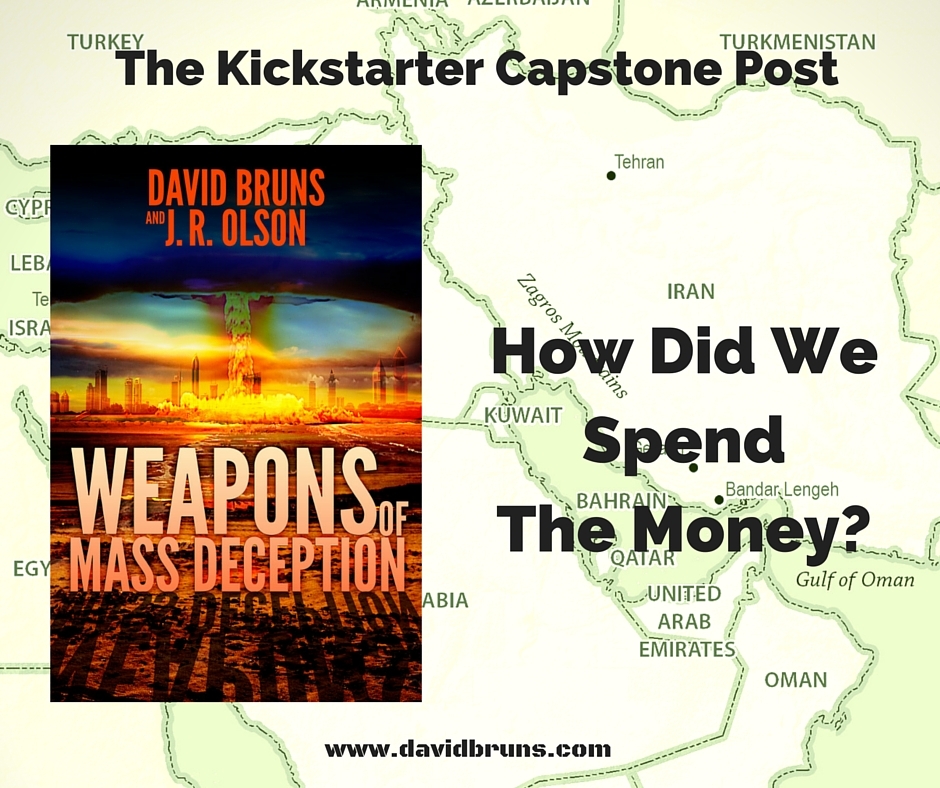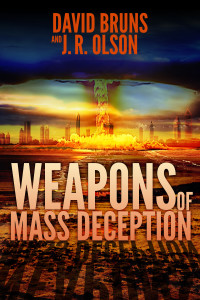WEAPONS OF MASS DECEPTION Kickstarter – How Did We Spend The Money?

Welcome back to the Two Navy Guys and Novel blog series where we talk about co-writing, publishing, and marketing a novel. Weapons of Mass Deception is available on Amazon in print and ebook formats.
This is the capstone post in our ongoing series about our very successful Kickstarter campaign to fund WMD. If you missed them, here’s a few of them:
Crowdfunding: Balancing Between the Crowd and the Money
WEAPONS OF MASS DECEPTION – Kickstarter Update
The Stats Behind Our Successful Kickstarter Campaign
7 Questions to Ask BEFORE You Crowdfund Your Art
The Rewards of a Kickstarter Campaign
How To Produce A Collector’s Edition of Your Novel
Money, Money, Money
We’ve done our best to be transparent about this process, and we plan to keep that trend going. Today, we’re talking about how we spent the $6,060 pledged to us by our 71 backers.
We ended up spending $6318 to produce the three editions of WMD and fulfill all the Kickstarter rewards. Here’s what our campaign spending looks like in graph form:

Let’s unpack these numbers:

Editing and Proofreading – Budget: $2500 Actual: $2244
This is the largest line item by far and doesn’t vary much whether we’re making one edition or ten editions. We hired a professional editor and a separate proofreader to make sure we got the final copy as close to perfect as possible.
 Collector’s Edition Printing – Budget: $1032 Actual: $1691
Collector’s Edition Printing – Budget: $1032 Actual: $1691
Our estimate for the cost of the hardback edition was $12/book. Actual cost was $13.52/book from Lightningsource, including shipping to our location. (Note: cost is $12.22 without shipping.) In addition, we made the decision to expand the printing run so we could give copies to individuals who supported the project along the way, such as beta readers, our first podcast interview, and our photographer. We also retained about a dozen copies to sell, and a few books to grace our personal libraries.
Book Production Costs – Budget: $1000 Actual: $770
Production costs include interior layout for each edition, covers for each edition, and maps for the Collector’s Edition. We saved some money here by doing the layout for the ebook ourselves.
Kickstarter Fees
Kickstarter takes a 5% commission from the total amount raised and then adds charges for credit card transaction fees. These fees amounted to $499 or 8.23% of the total amount raised.
Shipping Costs – Budget: $490 Actual: $469
When you promise signed books as rewards, remember you need to ship them to yourself, sign them, and then ship them to your backers. I’ve heard from a number of Kickstarter veterans that this is where rookies lose their shirts. As you can see, we performed pretty well to budget. Overseas shipping is very expensive, but Kickstarter does allow you to charge a premium to overseas supporters. And don't forget about packing materials (envelopes, boxes, tape, etc.). Of the $469 spent, $58 was for materials.
 Paperback Printing – Budget: $300 Actual: $341
Paperback Printing – Budget: $300 Actual: $341
We purchased fifty paperbacks to fulfill Kickstarter rewards and provide as gifts or review copies. Our estimate for the cost of the book via Createspace was $6/book. Actual cost of the book was $5.89, but once you add in shipping, the total cost came to $6.82 per book.
Miscellaneous Campaign Costs – $303
Everything else falls into this category, from the Kickstarter video production to ebooks and lunches that were part of the rewards for the higher tier backers.
So What Did We Learn?
- Experience Pays Off – Our cost estimates were pretty good overall. I’d produced a few novels already so I had a good sense of the costs to produce a book, such as layout and covers, and had business relationships with contractors I trusted.
- Watch Shipping Costs – Our estimates for the costs to buy the books wholesale were really close, but when we added in shipping we ran slightly over budget. Almost every Kickstarter veteran I talked to warned me about shipping costs, so we were hyper-vigilant in that area.
- Wait Until the Project is Done to Launch the Kickstarter – We had toyed with the idea of running the Kickstarter in late 2014, before our book had even gone to our editor. We decided to hold off and we’re so glad we did. The Kickstarter campaign is pressure enough without adding the stress of trying to project costs estimates and completion dates on an unfinished project. As a result, we hit every single delivery milestone on time or early.
And the most important lesson of all:
Be Generous
Our Kickstarter fully funded in less than a week and ended up at over 150% of goal. With that kind of support, we didn’t need to scratch for nickels and dimes. The generosity of our backers enabled us to do things like share copies of the Collector’s Edition with the many people who helped us along the way.
We never ran our campaign to make a profit; we ran our campaign to bring our book into the world as professionally as possible. We resolved to spend every penny of our backers’ money to fulfill that dream.
And we’re glad we did.
David Bruns is the creator of the sci-fi series The Dream Guild Chronicles, one half of the Two Navy Guys and a Novel blog series about co-writing a military thriller, and co-author of Weapons of Mass Deception, a story of modern-day nuclear terrorism.


